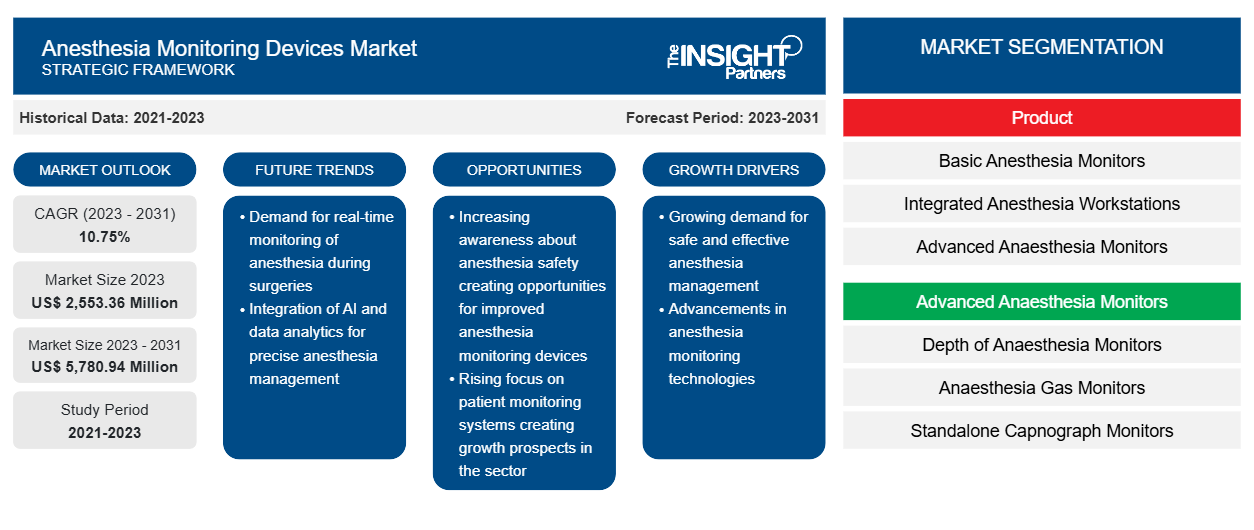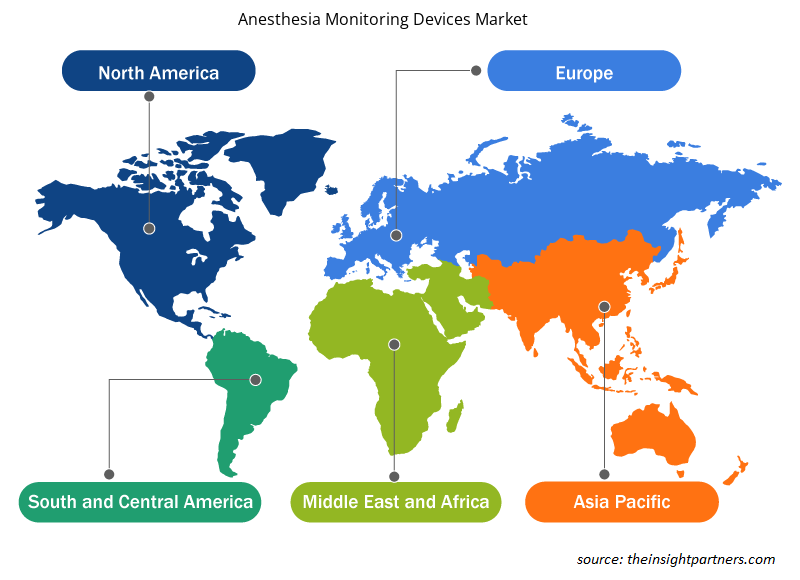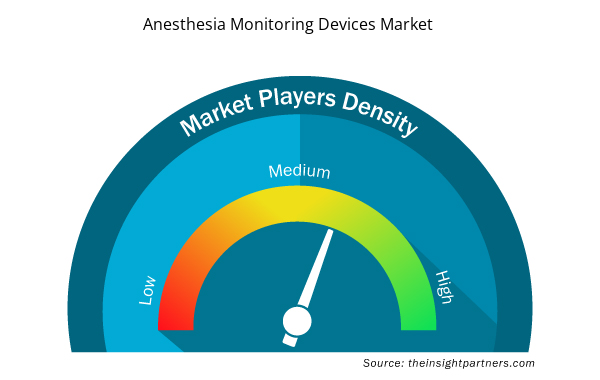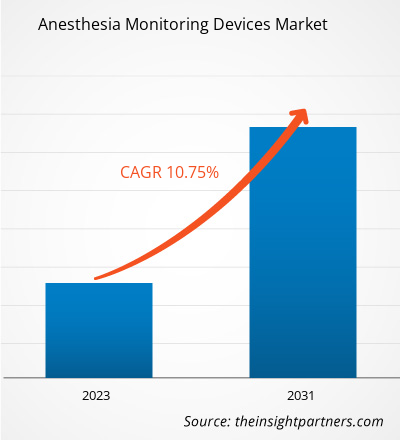[Research Report] Anesthesia monitoring devices market value is projected to grow from US$ 2.79 billion in 2024 to US$ 5.93 billion by 2031; the market is anticipated to record a CAGR of 11.5% from 2025 to 2031
Market Insights and Analyst View:
During surgeries, anesthesia monitoring devices monitor the patient's reaction to anesthesia. Oxygenation, circulation, breathing, and temperature measurements can be used to track the effect of anesthesia. The need for anesthesia monitoring devices varies from case to case and is dependent on the kind of surgery being performed. Anesthesia administration and monitoring during surgical procedures is a sophisticated skill that requires much training and experience. Anesthesia monitoring devices assist anesthesiologists in monitoring anesthesia dosage; additionally, good patient monitoring lowers the risks associated with both anesthesia and surgery.
The key factors driving the anesthesia monitoring devices market growth are the introduction of various new monitoring techniques, such as monitoring the depth of anesthesia, goal-directed fluid therapy, advanced neurological monitoring, improved alarm system, and technological advancements in objective pain assessment. Significant progress has been made in clinical practice development and clinical monitoring technology in the last few years. Anesthesia monitoring devices trends include the rapid digitalization of anesthesia monitoring devices.
Growth Drivers and Challenges:
Increasing Number of Surgeries is Driving Anesthesia Monitoring Devices Market
The rise in the number of surgeries significantly influences the anesthesia monitoring devices market size, driving demand for advanced monitoring technologies and solutions. The Lancet Commission on Global Surgery (LCoGS) highlighted that between 28% and 32% of the world's disease burden requires surgical care, anesthetic management, or both. The report "Global Surgery 2030 Evidence and Solutions for Achieving Health, Welfare, and Economic Development" indicates that 5 billion people worldwide lack access to safe, affordable surgical and anesthetic care when needed. An estimated 16.9 million deaths are attributed to surgical implications annually. Furthermore, the NCBI reports that 310 million surgical procedures are carried out yearly, around 20 million in Europe and 40–50 million in the US. Anesthesia monitoring devices ensure patient safety, optimize anesthesia delivery, and monitor vital signs throughout surgical procedures. The growing emphasis on patient outcomes, anesthesia management efficiency, and adopting sophisticated monitoring equipment in operating rooms are key factors contributing to the market expansion.
On the other hand, the high cost associated with anesthesia monitoring devices poses a significant challenge that can limit market growth and adoption rates within the healthcare industry. The initial investment required for acquiring advanced monitoring devices and additional training, maintenance, and upgrades can present financial barriers for healthcare facilities, particularly those operating under constrained budgets or resource limitations. The substantial cost of anesthesia monitoring equipment can strain capital expenditures, impact return on investment considerations, and potentially delay or deter healthcare providers from investing in state-of-the-art monitoring technologies. Moreover, ongoing operational costs, such as sensor replacements, software updates, and calibration services, contribute to the total cost of ownership, influencing purchasing decisions and overall cost-effectiveness assessments for healthcare institutions. The high cost of anesthesia monitoring devices may also challenge market penetration in regions with limited healthcare infrastructure, underserved populations, or economic disparities, where affordability and accessibility of advanced medical technologies remain critical considerations. Thus, the high cost associated with these scanning devices hinders the anesthesia monitoring devices market growth.
Customize This Report To Suit Your Requirement
You will get customization on any report - free of charge - including parts of this report, or country-level analysis, Excel Data pack, as well as avail great offers and discounts for start-ups & universities
Anesthesia Monitoring Devices Market: Strategic Insights

- Get Top Key Market Trends of this report.This FREE sample will include data analysis, ranging from market trends to estimates and forecasts.
You will get customization on any report - free of charge - including parts of this report, or country-level analysis, Excel Data pack, as well as avail great offers and discounts for start-ups & universities
Anesthesia Monitoring Devices Market: Strategic Insights

- Get Top Key Market Trends of this report.This FREE sample will include data analysis, ranging from market trends to estimates and forecasts.
Report Segmentation and Scope:
The anesthesia monitoring devices market analysis has been carried out by considering the following segments: based on product, advanced anesthesia monitors, technology, and end user. Geographically, the anesthesia monitoring devices market is segmented into North America (the US, Canada, and Mexico), Europe (the UK, Germany, France, Italy, Spain, and the Rest of Europe), Asia Pacific (China, Japan, India, Australia, South Korea, and the Rest of Asia Pacific), the Middle East & Africa (the UAE, Saudi Arabia, South Africa, and the Rest of Middle East & Africa), and South & Central America (Brazil, Argentina, and the Rest of South & Central America).
Segmental Analysis:
Product-Based Insights
Based on product, the market is segmented into basic anesthesia monitors, integrated anesthesia workstations, and advanced anesthesia monitors. The advanced anesthesia monitors segment held the largest anesthesia monitoring devices market share in 2023 and is anticipated to register the highest CAGR during 2023–2031.
Advanced Anesthesia Monitor-Based Insights
Based on advanced anesthesia monitors, the anesthesia monitoring devices market is segmented into basic anesthesia monitors, integrated anesthesia workstations, and advanced anesthesia monitors. The depth of anesthesia monitors segment is anticipated to hold a significant share by 2031.
Technology-Based Insights
Based on technology, the market is classified into bispectral index, auditory evoked potential, patient state index, cortical activity state index, and others. The bispectral index (BIS) segment is anticipated to hold a significant share by 2031.
End User-Based Insights
In terms of end users, the market is categorized into hospitals, specialty clinics, and ambulatory surgical centers. In terms of end users, the hospitals segment held the largest anesthesia monitoring devices market share in 2023 and is anticipated to be registered the highest CAGR during 2023–2031.
Anesthesia Monitoring Devices Market Regional Insights
The regional trends and factors influencing the Anesthesia Monitoring Devices Market throughout the forecast period have been thoroughly explained by the analysts at Insight Partners. This section also discusses Anesthesia Monitoring Devices Market segments and geography across North America, Europe, Asia Pacific, Middle East and Africa, and South and Central America.

- Get the Regional Specific Data for Anesthesia Monitoring Devices Market
Anesthesia Monitoring Devices Market Report Scope
| Report Attribute | Details |
|---|---|
| Market size in 2024 | US$ 2.79 Billion |
| Market Size by 2031 | US$ 5.93 Billion |
| Global CAGR (2025 - 2031) | 11.5% |
| Historical Data | 2021-2023 |
| Forecast period | 2025-2031 |
| Segments Covered |
By Product
|
| Regions and Countries Covered | North America
|
| Market leaders and key company profiles |
Anesthesia Monitoring Devices Market Players Density: Understanding Its Impact on Business Dynamics
The Anesthesia Monitoring Devices Market is growing rapidly, driven by increasing end-user demand due to factors such as evolving consumer preferences, technological advancements, and greater awareness of the product's benefits. As demand rises, businesses are expanding their offerings, innovating to meet consumer needs, and capitalizing on emerging trends, which further fuels market growth.
Market players density refers to the distribution of firms or companies operating within a particular market or industry. It indicates how many competitors (market players) are present in a given market space relative to its size or total market value.
Major Companies operating in the Anesthesia Monitoring Devices Market are:
- Mindray Medical International Limited
- Drägerwerk AG
- GE Healthcare
- Koninklijke Philips N.V.
- Schiller AG
- Criticare Systems, Inc.
Disclaimer: The companies listed above are not ranked in any particular order.

- Get the Anesthesia Monitoring Devices Market top key players overview
Regional Analysis:
The scope of the anesthesia monitoring devices market report encompasses North America, Europe, Asia Pacific, the Middle East & Africa, and South & Central America. North America held the largest share of the anesthesia monitoring devices market in 2023, and it is projected to maintain its dominance (in terms of share) during the forecast period. The US holds the largest market share in North America and the world. Market growth in this country is ascribed to the increase in the prevalence of cancer and the increasing geriatric population. For instance, the American Cancer Society stated that there were around 608,570 cancer-related deaths were reported, and over 1.9 million new cancer diagnoses were performed in the US in 2021. Additionally, the increasing number of surgical procedures, technological advancements, the presence of powerful industry players, and an increasing focus on patient safety during anesthesia administration are among the major factors predicted to boost overall business. Other factors include growing awareness regarding remote patient monitoring devices for improved accuracy, portability, connectivity, and user-friendly interfaces.
Competitive Landscape and Key Companies:
The anesthesia monitoring devices market forecast presented in this report can help stakeholders in this marketplace plan their growth strategies. Mindray Medical International Limited; Drägerwerk AG; GE Healthcare; Koninklijke Philips N.V.; Schiller AG; Criticare Systems, Inc.; HEYER Medical AG; Infinium Medical, Inc.; Siare Engineering International Group S.r.l.; and Nihon Kohden Corporation are a few key companies profiled in the anesthesia monitoring devices market report. These companies focus on expanding their offerings to meet the growing consumer demand worldwide. Their global presence allows them to serve many customers, subsequently allowing them to expand their market presence.
- Historical Analysis (2 Years), Base Year, Forecast (7 Years) with CAGR
- PEST and SWOT Analysis
- Market Size Value / Volume - Global, Regional, Country
- Industry and Competitive Landscape
- Excel Dataset



Report Coverage
Revenue forecast, Company Analysis, Industry landscape, Growth factors, and Trends

Segment Covered
Product, Advanced Anaesthesia Monitors, Technology, End User, and Geography

Regional Scope
North America, Europe, Asia Pacific, Middle East & Africa, South & Central America

Country Scope
This text is related
to country scope.
Frequently Asked Questions
What factors drive the anesthesia monitoring devices market?
The key factors driving the anesthesia monitoring devices market growth are the introduction of various new monitoring techniques, such as monitoring the depth of anesthesia, goal-directed fluid therapy, advanced neurological monitoring, improved alarm system, and technological advancements in objective pain assessment. Significant progress has been made in clinical practice development and clinical monitoring technology in the last few years. Anesthesia monitoring devices trends include the rapid digitalization of anesthesia monitoring devices.
What was the estimated anesthesia monitoring devices market size in 2024?
The anesthesia monitoring devices market was valued at US$ 2.79 billion in 2024.
What are the growth estimates for the anesthesia monitoring devices market till 2031?
The anesthesia monitoring devices market is expected to be valued at US$ 5.93 billion in 2031.
Who are the major players in the anesthesia monitoring devices market?
The anesthesia monitoring devices market has major market players, including Mindray Medical International Limited; Drägerwerk AG; GE Healthcare; Koninklijke Philips N.V.; Schiller AG; Criticare Systems, Inc.; HEYER Medical AG; Infinium Medical, Inc.; Siare Engineering International Group S.r.l.; and Nihon Kohden Corporation.
Which product segment dominates the anesthesia monitoring devices market?
Based on product, the market is segmented into basic anesthesia monitors, integrated anesthesia workstations, and advanced anesthesia monitors. The advanced anaesthesia monitors segment held the largest anesthesia monitoring devices market share in 2023 and is anticipated to register the highest CAGR during 2023–2031.
Which advanced anesthesia monitors segment dominates the anesthesia monitoring devices market?
Based on advanced anesthesia monitors, the anesthesia monitoring devices market is segmented into basic anesthesia monitors, integrated anesthesia workstations, and advanced anesthesia monitors. The depth of anaesthesia monitors segment is anticipated to hold a significant share by 2031..
What is anesthesia monitoring devices?
During surgeries, anesthesia monitoring devices monitor the patient's reaction to anesthesia. Oxygenation, circulation, breathing, and temperature measurements can be used to track the effect of anesthesia. The need for anesthesia monitoring devices varies from case to case and is dependent on the kind of surgery being performed. Anesthesia administration and monitoring during surgical procedures is a sophisticated skill that requires much training and experience. Anesthesia monitoring devices assist anesthesiologists in monitoring anesthesia dosage; additionally, good patient monitoring lowers the risks associated with both anesthesia and surgery.
Trends and growth analysis reports related to Life Sciences : READ MORE..
The List of Companies - Anesthesia Monitoring Devices Market
- Mindray Medical International Limited
- Drägerwerk AG
- GE Healthcare
- Koninklijke Philips N.V.
- Schiller AG
- Criticare Systems, Inc.
- HEYER Medical AG
- Infinium Medical, Inc.
- Siare Engineering International Group S.r.l.
- Nihon Kohden Corporation

 Get Free Sample For
Get Free Sample For